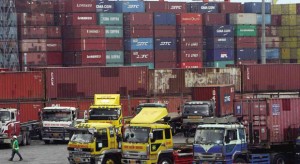Economic loss from truck ban to hit P320B
The controversial Manila truck ban can cost the Philippine economy as much as P320 billion and put at risk about a million manufacturing jobs without an alternative transport linkage between the economic zones in the Cavite-Laguna-Batangas-Rizal-Quezon (Calabarzon) area and the port of Manila, an economist from American banking giant Citigroup warned.
In a macro research note dated March 7, Citi economist for the Philippines Jun Trinidad said the ensuing transportation bottleneck could chop at least 1 percent to as much as 5 percent off the country’s gross domestic product (GDP) mostly affecting nontechnology export commodities.
This is one of the first private sector report to quantify the economic cost of Manila’s truck ban, suggesting a magnitude that may later on require “intervention” from the national government. In peso terms, the GDP costs were estimated at a low of P61.2 billion to as high as P320 billion, which Trinidad said would dwarf the potential benefits of P30 billion in real terms from the reduced traffic envisioned by the truck ban.
“Manila’s truck ban casts a dark shadow on exports and GDP prospects. It may be early days, but we may be counting opportunity losses if the truck ban stays without having an alternative and effective transport option that links’ Calabarzon’s economic zones with the port of Manila,” Trinidad said.
Calabarzon is the second most densely populated region in the country, an industrial hub and a big contributor to GDP of the Philippines, now Southeast Asia’s fastest-growing economy.
This new policy bans eight wheelers and vehicles with a gross weight of above 4,500 kilos from plying Manila’s streets between 5 a.m. and 9 p.m in an apparent bid to ease traffic as construction starts on key tollroad projects such as the roads linking the north and south Luzon expressways. There is a temporary concession to allow trucks to ply the streets between 10 a.m. and 3 p.m. within the next six to eight months but this leeway is still deemed insufficient by the Philippine Economic Zone Authority (Peza) officials and ecozone locators.
“Local/foreign locators in the Peza zones of Calabarzon with their export-bound cargo requiring international shipping services are destined for the port of Manila. Over time, export delays that divert foreign buyers’ interest could jeopardize production and jobs in Calabarzon,” Trinidad said.
On the other hand, Trinidad said technology producers that avail themselves of airline services in shipping out their goods may be spared unlike nontech manufacturers such as those producing car parts, with their containerized shipments that exit through Manila’s port.
“The truck ban, which highlights the limited transport access and its potentially negative impact on exports/output, attests to the infrastructure bottlenecks that can constrain strong growth prospects,” Trinidad said, noting that even the Batangas City port within the Calabarzon area itself did not have the same capacity as the Manila port.
This renders crucial the infrastructure spending and public-private partnership (PPP) project implementation to ease growth bottlenecks in Metro Manila and the other regions, the economist said.
“We sense simmering policy ‘conflict’ between national government plans that want to fast-track growth, including jobs/income creation, and local government objectives with legitimate but isolated cost/benefit concerns directed at limited constituencies,” Trinidad said, citing South Cotobato’s $5.9-billion Tampakan copper-gold mining project that was stalled by the local government’s decision to ban “open pit” mining contrary to the national mining law. As such, he said “state intervention may be needed if Manila’s truck ban results in transport bottlenecks and export delays.”
In estimating the economic impact of the truck ban, the Citi economist assumed the following:
nontech manufacturing such as metal components, garments, will be affected since these require “containerized shipments” that need to be exported via the port of Manila but with the truck ban exemptions, raw and processed food and other agro-based exports would be spared;
real exports of garments and accessories, refined copper products, ignition wiring sets, metal components and basket works as a share to GDP comprise the basis for the low percentage of GDP (1 percent) likely affected by the truck ban ordinance. To this average real export ratio (2011-13), Citi took a 42 percent share, which is the percentage of manufacturing output coming out of Calabarzon relative to national manufacturing GDP and also assumed that 80 percent of Calabarzon’s manufactured output was for exports;
In estimating the larger 5 percent share of GDP likely threatened by the ban, Citi expanded the real value of the export commodities to include other non-tech exports. It obtained the three-year average ratio of the larger set of nonelectronic exports to GDP and applied the same percentages to focus on those produced in the Peza zones of Calabarzon;
The estimated one-million jobs threatened by the truck ban assumes that Calabarzon’s manufacturing segment contributes 34 percent to the country’s total manufacturing employment of 3.1 million, and
Citi quantified the P30-billion potential relief from a reduction in traffic based on a daily traffic congestion cost of P2.4 billion as estimated by the Japan International Cooperation Agency (Jica) in an earlier study.

